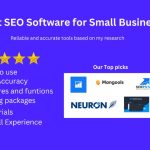Do you run a business and want to get more quality leads coming in the door? Of course you do – what business owner doesn’t want that? I feel you. Lead generation is tough work. You can have the best product or service out there, but if people aren’t finding your website online, then no one knows you exist outside of your immediate connections. It’s a real problem in our increasingly digital world. But here’s the good news – with some search engine optimization (SEO) know-how, you can dramatically increase your site’s visibility and draw way more of your ideal customers in. SEO may sound technical and intimidating, but it doesn’t have to be with the right guidance. And that’s exactly what this guide aims to provide. I’m going to walk you through a best practices SEO for lead generation. Sound good? Let’s do this!

Why SEO Matters for Lead Gen
Before we dive into the nitty gritty tactics, it’s important to level-set on why SEO really matters when your goal is generating more leads.
Here are 3 key reasons:
1. Increased Reach & Discovery
The number one reason SEO for lead generation is crucial for lead gen is that it expands your reach and discovery exponentially.
Think about it – there are over 3 billion Google searches per day globally. When your website ranks high in those search results for queries related to your business offerings, you put your brand in front of way more of your ideal prospects. More eyeballs = more leads. It’s that simple.
Rather than just relying on people within your existing network finding out about what you offer, SEO helps you get on the radar of tons more potential customers actively looking for solutions like yours.
2. Higher Quality Traffic
It’s not just about more traffic though – it’s about more qualified traffic. The searchers who click on your site after finding you in Google results for a relevant query are inherently higher quality.
Why? Because they have a specific need related to your business and they’re in research mode. It’s way easier to convert that traffic into leads because they’re already interested and engaged.
Contrast that to trying to generate leads through broad social media ads to a general audience. Reaching people at that perfect moment where they’re already looking for you is marketing gold.
3. Brand Credibility
Finally, don’t underestimate the brand credibility value of ranking high in search engine results.
When you show up on page 1 of Google for terms related to your offerings, you come across as an authority. Even if searchers have never heard of you before, seeing you rank above the big household names subconsciously makes you seem trustworthy and influential in your niche.
That’s hugely beneficial for capturing more leads who don’t know you yet, but infer quality and leadership from your search visibility. Positioning yourself as an expert through SEO builds confidence in what you provide before visitors even click through to your site.
So in summary – more visibility to your ideal audience + qualified visitors ready to engage + implicit brand credibility = killer lead gen combo.

Crafting An Optimal SEO Strategy
Hopefully I’ve convinced you why dialing in your SEO is 100% mandatory if lead generation is your top business objective right now. You simply can’t afford to leave website traffic on the table in today’s oversaturated digital landscape.
But doing SEO effectively requires more than just sporadic tactics here and there when you think of it. To really move the needle, you need a documented strategy across a few core areas.
Based on proven SEO for lead generation best practices, here is the tactical framework I recommend:
1. Keyword Research
Keyword research lays the foundation for the entire SEO process, so that’s where I suggest starting.
Your first task is identifying the specific queries your ideal prospects are using to search for solutions related to your offerings. Once you have that list compiled, you’ll tailor your on-page optimization and content creation around ranking for those high-potential terms.
To compile your primary “seed” keywords for research, put yourself in your target customer’s shoes. If you sold them, what language would they use to describe their pain points or needs?
You can utilize free keyword research tools like Google’s Keyword Planner, UberSuggest, Soovle, or SEMRush to expand your seed list into a bigger grouping of keyword opportunities related to parameters like search volume and competitiveness.
As you research terms relevant to your business, categorize them in order of priority tiers:
- Tier 1 – Highest potential value – stable search volume, reasonable ability to rank
- Tier 2 – Moderate potential – decent search volume, somewhat difficult to rank
- Tier 3 – Lowest potential – either low search volume or incredibly hard to rank
Rinse and repeat this process across your whole range of offerings to develop a holistic keyword list that forms the foundation for SEO targeting.
Pro Tip: Set up tracking in Google Analytics for your high priority keywords so you can monitor rankings progress month-over-month. Visibility into how you’re trending is key for optimizing over time.
2. On-Page SEO
Once your keystone keywords are nailed down, systematically optimizing top site pages around them is next on the agenda. This on-page SEO builds relevance and authority to rank for those terms.
Elements I recommend focusing on include:
URL Structure: URLs themselves should contain primary keywords where logical. For example, if you offer dog training services, having the page URL formatted with that term (yourdomain.com/dog-training) adds SEO weight vs a generic URL.
Page Titles: Page titles appear both at the top of the browser and as headline snippets in search engine results. Keep titles under 60 characters, with primary keywords front-loaded.
Headings (H1, H2): Break content into organized sections using heading tags (H2, H3, etc). Topically format key sections around secondary long tail variations of your target keywords.
Content: Write helpful, relevant 1500+ word content around ranking keywords, working them in naturally without over-optimizing. Include related long tail keyword variants.
Media: Images, videos, infographics – they all help reinforce page relevance visually. Ensure media filenames and alt text reference target keywords too.
Internal Links: Cross-link related site content to pages you’re optimizing for lead gen keywords. This spreads relevance “link juice” around for better rankings.
That’s just a snapshot of key on-page elements to optimize. Comprehensively evolve each page targeting specific keywords to build authority and rankings.
3. Link Building
Beyond your site’s content itself, the number and authority of external sites linking back to your optimized pages also hugely impacts search rankings.
Google interprets backlinks as “votes” of confidence that your page offers value worthy of recommendation to others. More referral links (especially from reputable sites) equal higher rankings.
So actively building external links needs to be a core piece of your SEO strategy. Tactics like:
- Reach out to similar blogs/sites to be included in relevant content roundups, lists, comparisons etc
- Create and distribute great guest posts with embedded links putting you in front of new audiences
- Promote your best content on social channels daily to drive inbound shares
- Develop relationships with influencers, journalists etc to get featured authoritative links
- Publish and promote new high-quality content consistently to generate links over time
Set monthly goals around number of tier 1 backlinks achieved from sites with metrics like DA/PA in the 30+ range. Track progress to spot gaps and optimize outreach. Links compound, so stay aggressive here.
4. Technical SEO
With content created and linking building momentum, don’t overlook the technical side of SEO for lead generation. Getting site architecture and tech parameters correctly configured removes friction for both search engine bots AND visitors trying to engage with your content.
Some key technical elements to audit include:
- Fast load speeds: bloated pages load slowly and increase visitor bounce rate. Optimize speed through image compression, reduced redirects, efficient code etc.
- Mobile responsiveness: With growing search traffic coming from mobile, ensure site displays well cross-device.
- SSL configured: Having SSL helps pages rank better and prevents security alerts scaring visitors.
- XML sitemap: Generated sitemap files help search bots better index all of your site pages. Submit sitemaps to engines for better crawl efficiency.
- Robots.txt: Configure permissions in your root robots.txt file to guide search bots towards or away from pages as needed.
- 404 monitoring: Identify and redirect broken links causing 404 errors to improve visitor experience.
- Structured data: Adding schema markup to pages helps engines understand page content in search snippets.
- Accessibility: Ensure your site’s code, content and media meet at minimum WCAG 2.1 accessibility compliance for the best inclusive visitor experience.
Staying on top of these technical site health factors contributes to both better visitor engagement and search engine rankings – critical for lead conversion.
5. Analytics & Reporting
Wrapping up the executional pillars of an SEO lead gen strategy, accurately tracking key metrics and progress against keywords is huge for optimizing efforts.
On a weekly basis, log in to Google Analytics to monitor elements like:
- Rankings progress for target keywords
- Search impression volume
- Click through rates from search engines
- Bounce rates from search traffic
- Site speed metrics
- Organic traffic growth
Course correct in real-time based on what the data says is working (or not).
Additionally build out monthly SEO reports for leadership covering traffic growth, conversions by keyword, top landing pages, linking progress and technical health issues. Quantify the revenue impact of your efforts.
Analytics visibility is invaluable for continually perfecting strategy and proving the ROI of SEO investment to inform budgets.
There you have it – a comprehensive step-by-step SEO framework tailored to driving more quality leads to your site by getting found for the right searches.
From research to on-page factors to links to technical considerations and reporting – attacking SEO holistically across those pillars is proven to work when done right.
But all that doesn’t mean SEO is easy or a quick fix. Achieving and maintaining rankings takes serious time and work. But the payoff in exponential qualified visibility can be well worth the effort for lead gen.
Let’s wrap up with some common questions I often get asked when strategizing SEO specifically for lead generation goals.
Frequently Asked Questions
Q: How long does it take to see SEO results?
Rankings and traffic gains take real patience and persistence. Typically allow at least 3-6 months before seeing measurable lift, and 6-12+ months for major movement. Stick with it – SEO is not fast but compounds over time.
Q: How much should I budget for lead gen SEO?
Depends greatly on competition, site size, current visibility gaps and resource bandwidth. But at minimum dedicate 15-20 hours per month towards execution on the foundational areas covered above. Outsourcing to an SEO agency can provide bandwidth if tackling fully in-house isn’t viable. Expect around $750-$1500 per month minimum if going that route depending on needs and locations.
Q: What SEO stats matter most for lead gen tracking?
Focus most on metrics directly tied to site visitor behavior that indicates conversions potential – lower bounce rates on pages ranking for commercial keywords, higher average time on site from organic traffic, more contact form completions from search referrals etc. Use UTM tracking codes to isolate SEO lead actions from other channels. Monitor search click volume, CTR, and rankings to understand performance underneath those conversion metrics too.
Q: How often should keywords be updated?
Fully refresh target core keywords every 6-8 months to capture search behavior evolution and emerging opportunities. But monitor your existing term set more frequently (monthly) to spot any major drops that require adjustments sooner. New keywords should continually get added over time as new pages and content get created. SEO is always an evolving process.
Q: What SEO tasks I can outsource?
Technically any SEO tasks CAN be outsourced, but typically things like content creation, outreach for links and citations, site audits/tech optimization, rank tracking etc provide the biggest time savings leverage. Strategy development and day-to-day SEO program management requires deeper internal ownership for sustainable success. Finding the right agency partner is key so insight isn’t lost fully outsourcing execution.
Wrapping Up
Well there you have it – a comprehensive blueprint for leveraging search engine optimization to drive more quality leads and grow your business.
I realize that was A LOT to digest in one sitting. This stuff certainly isn’t easy, but I aimed to boil down a proven structure that meets you where you are to incrementally improve website visibility and conversions over time.
The key is avoiding overly complex or tactical advice in favor of that sustainable 20/80 Pareto principle. Consistent focus on just the most vital 20% of SEO for lead generation foundations outlined here will yield 80% of possible organic lead generation results.
In the realm of building trust and credibility: SEO for financial services, navigating the intricate landscape of search engine optimization requires a strategic approach. If executing everything at once seems overwhelming, heed the wisdom that Rome wasn’t built in a day; instead, choose 1-2 key areas to initiate the process and build positive momentum. Just as organic rankings take time, a methodical SEO investment, meticulously tailored to enhance conversions for your ideal buyer persona, will undoubtedly yield substantial dividends in the long run.
So don’t put it off any longer – go make some strategic tweaks this week to start increasing your site’s discoverability. Your future leads are eagerly searching and waiting to connect with your brand. Go meet them where they already are!
I know you’ve got this. Now get out there and turn some of those untapped searches into sales! Let me know if any other SEO or digital marketing questions come up. I’m always happy to chat more in depth.







